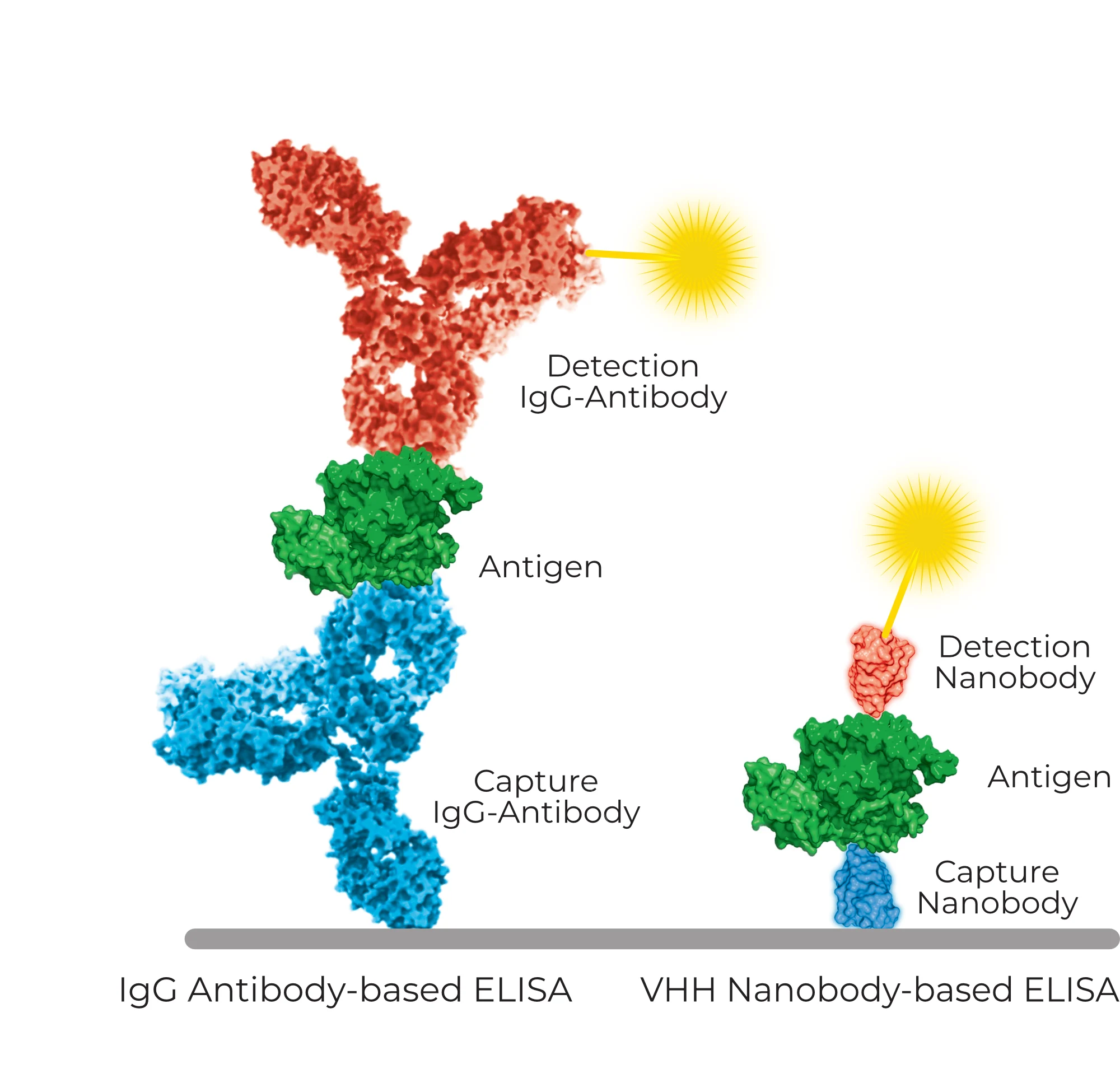ELISA
What is an ELISA
An ELISA is one of the most widely used immunoassays for detecting and quantifying proteins, peptides, and other biomolecules. It resembles a Lateral Flow Assay (LFA) in principle but is performed in microtiter plates with controlled incubation and washing steps.
Most people know ELISA as the laboratory “gold standard” in diagnostics, research, and quality control. In a sandwich ELISA, a target molecule is first captured by an immobilized antibody. A second antibody, linked to an enzyme, generates a measurable colorimetric or fluorescent signal. Competitive formats exist as well, particularly for small molecules.
Compared to LFAs, ELISAs are typically more sensitive and quantitative, though they require lab infrastructure and longer assay times.

VHH Nanobodies for Next-Gen ELISAs
Traditionally, conventional antibodies are used, but the shift to antibody fragments such as VHH nanobodies opens new opportunities. Nanobodies are compact, robust, and easy to produce at scale. Their small footprint allows dense surface immobilization, and their high specificity supports clean signal generation with minimal background.
Why nanobodies in ELISAs?
-
High stability & small footprint → supports high binder density and clean signal formation on nitrocellulose.
-
Fast, scalable production in bacterial or yeast expression reduces cost and lead time.
-
Excellent specificity → in general, smaller epitope recognition allows selection of unique binders without cross-reactivity against comparable targets.
How we approach nanobody ELISAs
- Matched pairs for sandwich formats
We provide high-affinity nanobody binders from our immune and synthetic libraries, and can identify non-competing pairs that are suitable for capture and detection roles in an ELISA.
- Engineering flexibity
Nanobodies can be fused to tags or enzymes, or formatted into multivalent constructs, enabling tailored signal strategies.
- Assay compatibility
We assess binder stability and cross-reactivity under ELISA conditions and optimize conjugation where needed.
What we deliver
-
Nanobody discovery & engineering: From immune/synthetic libraries to high-affinity binders.
-
Feasibility testing: Pairing, competition, and expression analysis for ELISA applications.
-
Collaboration on assay development: Working with your team to fine-tune plate coating, blocking, detection chemistry, and readout.
Use cases & outlook
Our role is to provide VHH nanobodies as next-generation ELISA reagents. By combining the robustness of ELISA with the unique properties of nanobodies, we help create assays that are more specific, more stable, and faster to produce. Together, we can advance ELISA from concept to validated prototype.
Select Source
-
Yu R, Wang J, Zhang L, Li X, Wang X, Li Y, et al. Development of a nanobody-based competitive ELISA for the sensitive detection of antibodies against porcine deltacoronavirus (PDCoV) S protein. J Clin Microbiol. 2025;63(5):e02184-24. doi:10.1128/jcm.02184-24.
-
Li Y, Gao P, Huang J, Wu L, Xu Z, Li M, et al. Nanobody-based indirect competitive ELISA for the detection of aflatoxin M1 in dairy products. Sci Rep. 2025;15:11234. doi:10.1038/s41598-024-83869-4.
-
Chen W, Liu J, Zhao S, Feng H, Zhang Y, Xu H, et al. Phage-displayed nanobody-based competitive immunoassay for detection of African swine fever virus antibodies. Virol J. 2025;22:145. doi:10.1186/s12985-025-02781-z.
-
Bao K, Li J, Yang H, Zhang D, Zhang Y, Li X, et al. Dual improved ELISA (DI-ELISA) based on multimeric nanobody and polymerized horseradish peroxidase. Food Chem. 2024;436:137040. doi:10.1016/j.foodchem.2024.137040.
-
He Q, Xu L, Wang H, Tang Y, Sun J, Li Z, et al. Strategies for the immobilization and signal amplification of a double nanobody sandwich ELISA. Anal Chem. 2024;96(5):8703-11. doi:10.1021/acs.analchem.4c04505.
